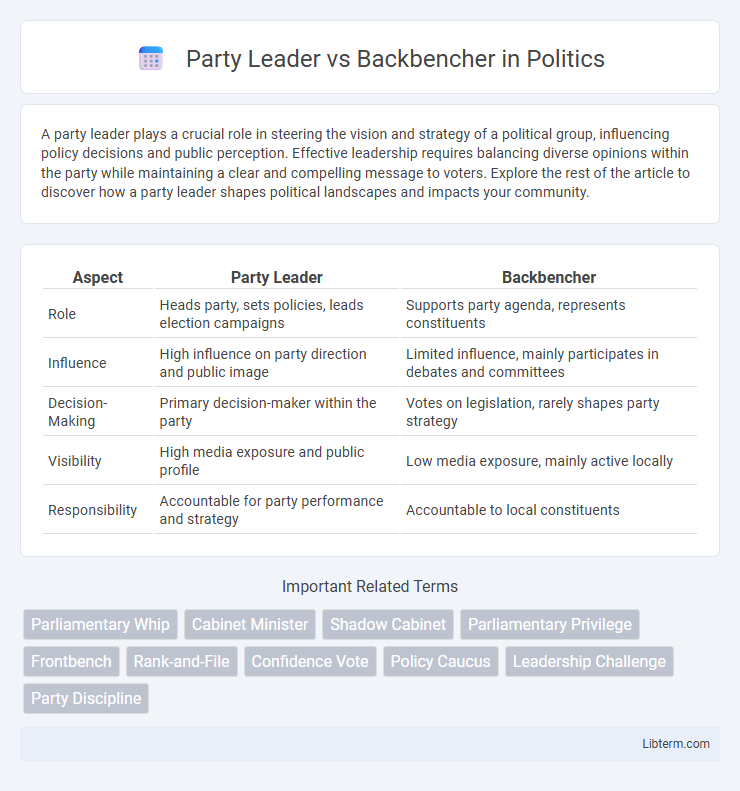A party leader plays a crucial role in steering the vision and strategy of a political group, influencing policy decisions and public perception. Effective leadership requires balancing diverse opinions within the party while maintaining a clear and compelling message to voters. Explore the rest of the article to discover how a party leader shapes political landscapes and impacts your community.
Table of Comparison
| Aspect | Party Leader | Backbencher |
|---|---|---|
| Role | Heads party, sets policies, leads election campaigns | Supports party agenda, represents constituents |
| Influence | High influence on party direction and public image | Limited influence, mainly participates in debates and committees |
| Decision-Making | Primary decision-maker within the party | Votes on legislation, rarely shapes party strategy |
| Visibility | High media exposure and public profile | Low media exposure, mainly active locally |
| Responsibility | Accountable for party performance and strategy | Accountable to local constituents |
Understanding Party Leaders and Backbenchers
Party leaders hold key positions within political parties, directing policy agendas, managing party discipline, and representing the party in public and legislative forums. Backbenchers, as rank-and-file members of the legislature, typically have less influence on party decisions but play a crucial role in representing constituents and providing input during debates and committee work. Understanding the dynamic between party leaders and backbenchers is essential for analyzing party cohesion, legislative strategy, and the balance of power within parliamentary systems.
Roles and Responsibilities: Party Leader
Party Leaders set the political agenda, develop party policies, and represent the party in public and parliamentary debates. They coordinate election campaigns, manage party unity, and make strategic decisions to advance the party's legislative goals. Their responsibilities also include negotiating with other political figures and fostering party discipline among members.
Duties and Influence: Backbencher
Backbenchers primarily focus on representing their constituents' interests and supporting party policies through voting and participation in parliamentary committees. Their duties include raising local concerns, scrutinizing legislation, and contributing to debates, though they lack the executive responsibilities held by party leaders. Despite limited direct influence on party strategy, backbenchers can shape policy through grassroots feedback and by exerting pressure on party leadership during internal discussions.
Pathways to Leadership and Backbench Roles
Party leaders often ascend through structured pathways including active participation in youth wings, holding junior ministerial roles, and demonstrating strategic acumen within party committees. Backbenchers serve as crucial components of parliamentary democracy by representing local constituencies, scrutinizing legislation, and influencing policy through committee work and private member's bills. While party leadership roles demand visibility, decision-making authority, and media presence, backbenchers focus on constituency service, regional interests, and internal party debates that shape legislative priorities.
Decision-Making Power: Who Holds More Sway?
Party leaders hold significantly more decision-making power compared to backbenchers, as they set policy agendas, influence party strategy, and direct legislative priorities. Backbenchers, while representing constituents and contributing to debates, typically have limited sway over major decisions and must align with the leadership to impact outcomes. The concentration of authority in party leaders ensures they dominate critical votes and leadership assessments, reinforcing their central role in political decision-making.
Public Perception: Leader vs Backbencher
Party leaders are often perceived as influential decision-makers who shape policy and represent their party's vision to the public, enhancing their visibility and public trust. In contrast, backbenchers are viewed as less prominent figures with limited influence, often focusing on constituency issues and supporting party agendas quietly. This distinction shapes public perception, where leaders attract media attention and scrutiny while backbenchers maintain a lower profile with more localized recognition.
Impact on Policy and Legislation
Party leaders possess significant influence over policy direction and legislative priorities, often shaping the agenda through strategic decision-making and party discipline. Backbenchers typically have limited direct impact on legislation but can affect policy by voicing constituent concerns and participating in committee work. The balance between leadership control and backbencher advocacy plays a crucial role in the democratic process and legislative outcomes.
Challenges Faced by Party Leaders and Backbenchers
Party leaders face challenges such as maintaining party unity, managing diverse political agendas, and responding to public scrutiny while setting strategic directions. Backbenchers often struggle with limited influence on policy-making and gaining visibility within their party and electorate. Both roles require navigating internal party dynamics, but leaders must balance leadership responsibilities with broader national expectations.
Collaboration and Conflict Within Parties
Party leaders shape policy agendas and maintain party discipline, fostering collaboration to unify members around common goals. Backbenchers influence party dynamics by voicing grassroots concerns, which can create tension when their interests diverge from leadership priorities. Effective party functioning depends on balancing leader authority with backbencher input to manage conflicts and promote cohesion.
The Evolution of Political Roles in Modern Democracies
Party leaders have evolved from mere figureheads to strategic decision-makers who shape policy agendas and party ideology in modern democracies. Backbenchers, traditionally passive supporters, increasingly influence legislative outcomes through committee roles and constituency advocacy. This shift reflects a more dynamic political structure where both leadership and rank-and-file members contribute to governance and party cohesion.
Party Leader Infographic

 libterm.com
libterm.com